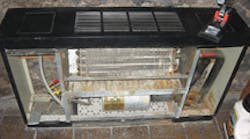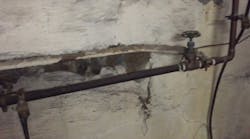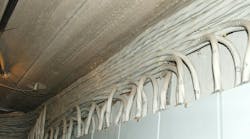As usual, never consider the following commentary associated with these photos as a formal interpretation of the National Electrical Code (NEC). Without criticizing anyone or any product, the following scenarios present us with serious safety questions.
All references are based on the 2008 NEC.
WANNABE ELECTRICIAN TURNED PLUMBER
Daryl Towne, a project manager with Total Electric, Inc., located in Wichita, Kan., ran across this when his team was remodeling a building. “The copper tubing was poured in the slab 30 years ago when the building was first built,” says Towne. “I guess they ran out of PVC and used what the plumber had on hand.”
The internal diameter of this kinky copper tubing may be found in the plumbing code, and could possibly be properly sized for these wires, as noted in Table 4 Dimensions and Percent Area of Conduit and Tubing (Areas of Conduit or Tubing for the Combinations of Wires Permitted in Table 1, Chapter 9 in the NEC).
However, this installation is in no way acceptable. It violates the requirements of 110.8, which states “Only wiring methods recognized as suitable are included in this Code. The recognized methods of wiring shall be permitted to be installed in any type of building or occupancy, except as otherwise provided in this Code.”
HUNG OUT TO DRY
Tom Bates, a student from Lancaster, Pa., ran across this unusual installation at a roadside farmers' market in Pennsylvania. “Where was the building inspector for this one,” says Bates.
This installation, once properly secured to the building, is now improperly supported because of the new siding job. There may be damaged service entrance conductors, raceway, fittings, enclosures, and feeders, etc. In my opinion, any new siding job should also include an electrical inspection. Some of the rules that are violated can be found in Art. 230 (Services), Art. 250 (Grounding and Bonding), and Art. 338 (Service-Entrance Cable). We could fill up this page with the appropriate section numbers.
Found a Code Violation? E-mail your photos (no cell phone images, please) to Joe Tedesco at [email protected].






